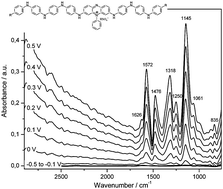The structure and stabilization of charged states during p-doping of polyaniline (PANI) were studied by in situATR-FTIR spectroelectrochemistry. The role of phenazine-like units in several copolymers of aniline and a phenazine derivative (3,7-diamino-5-phenylphenazinium chloride, phenosafranine) was investigated by spectroelectrochemistry. PANI and three copolymers with different aniline to phenosafranine ratio were electrochemically prepared. FTIR spectra of as-prepared polymers as well as in situFTIR spectra during the oxidation of the polymers give evidence of the presence of phenazine-like units in the structure of electrochemically prepared PANI, as shown by vibrations of the phenazine rings. New bands corresponding to the in-plane and out-of-plane C–H vibration of 1,2,4-trisubstituted benzene nuclei in the phenazine skeleton are found at 1033, 957, 880, 766 and 681 cm−1. The potential dependence of IR bands observed during oxidation of the polymers was compared to that of the ESR intensity and the absorption data and points to the diamagnetic species like π-dimers formed at higher oxidation level of PANI. This charged state is shown to be fixed at the link of the phenazine-like units with the linear segments of PANI.

You have access to this article
 Please wait while we load your content...
Something went wrong. Try again?
Please wait while we load your content...
Something went wrong. Try again?


 Please wait while we load your content...
Please wait while we load your content...